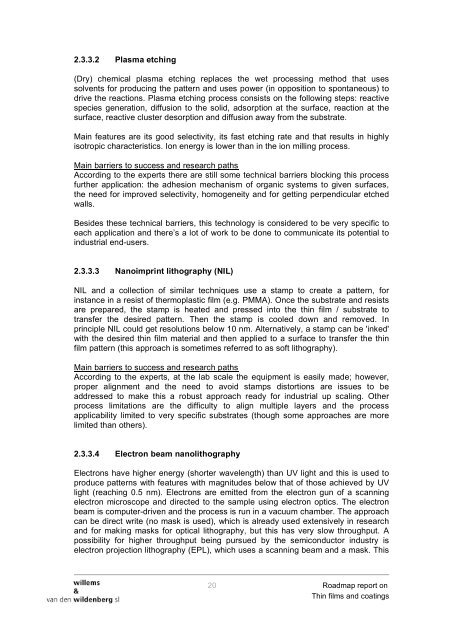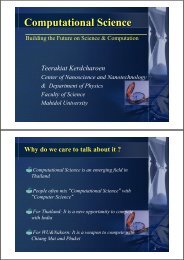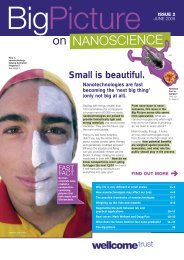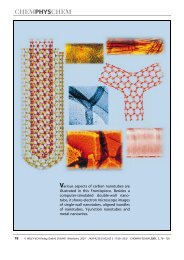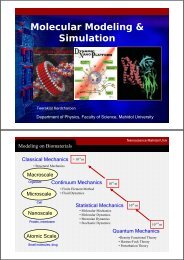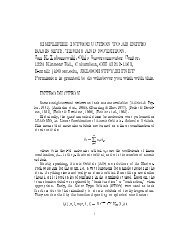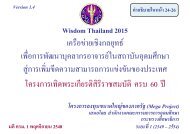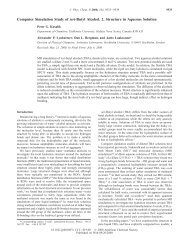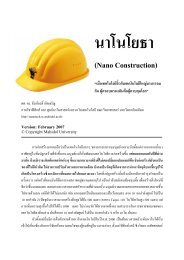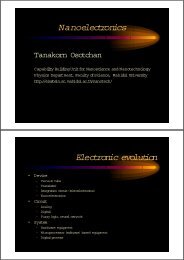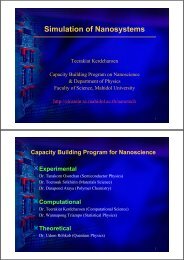'Thin films & coatings' Roadmap - Nano Mahidol
'Thin films & coatings' Roadmap - Nano Mahidol
'Thin films & coatings' Roadmap - Nano Mahidol
You also want an ePaper? Increase the reach of your titles
YUMPU automatically turns print PDFs into web optimized ePapers that Google loves.
2.3.3.2 Plasma etching<br />
(Dry) chemical plasma etching replaces the wet processing method that uses<br />
solvents for producing the pattern and uses power (in opposition to spontaneous) to<br />
drive the reactions. Plasma etching process consists on the following steps: reactive<br />
species generation, diffusion to the solid, adsorption at the surface, reaction at the<br />
surface, reactive cluster desorption and diffusion away from the substrate.<br />
Main features are its good selectivity, its fast etching rate and that results in highly<br />
isotropic characteristics. Ion energy is lower than in the ion milling process.<br />
Main barriers to success and research paths<br />
According to the experts there are still some technical barriers blocking this process<br />
further application: the adhesion mechanism of organic systems to given surfaces,<br />
the need for improved selectivity, homogeneity and for getting perpendicular etched<br />
walls.<br />
Besides these technical barriers, this technology is considered to be very specific to<br />
each application and there’s a lot of work to be done to communicate its potential to<br />
industrial end-users.<br />
2.3.3.3 <strong>Nano</strong>imprint lithography (NIL)<br />
NIL and a collection of similar techniques use a stamp to create a pattern, for<br />
instance in a resist of thermoplastic film (e.g. PMMA). Once the substrate and resists<br />
are prepared, the stamp is heated and pressed into the thin film / substrate to<br />
transfer the desired pattern. Then the stamp is cooled down and removed. In<br />
principle NIL could get resolutions below 10 nm. Alternatively, a stamp can be 'inked'<br />
with the desired thin film material and then applied to a surface to transfer the thin<br />
film pattern (this approach is sometimes referred to as soft lithography).<br />
Main barriers to success and research paths<br />
According to the experts, at the lab scale the equipment is easily made; however,<br />
proper alignment and the need to avoid stamps distortions are issues to be<br />
addressed to make this a robust approach ready for industrial up scaling. Other<br />
process limitations are the difficulty to align multiple layers and the process<br />
applicability limited to very specific substrates (though some approaches are more<br />
limited than others).<br />
2.3.3.4 Electron beam nanolithography<br />
Electrons have higher energy (shorter wavelength) than UV light and this is used to<br />
produce patterns with features with magnitudes below that of those achieved by UV<br />
light (reaching 0.5 nm). Electrons are emitted from the electron gun of a scanning<br />
electron microscope and directed to the sample using electron optics. The electron<br />
beam is computer-driven and the process is run in a vacuum chamber. The approach<br />
can be direct write (no mask is used), which is already used extensively in research<br />
and for making masks for optical lithography, but this has very slow throughput. A<br />
possibility for higher throughput being pursued by the semiconductor industry is<br />
electron projection lithography (EPL), which uses a scanning beam and a mask. This<br />
20 <strong>Roadmap</strong> report on<br />
Thin <strong>films</strong> and coatings


